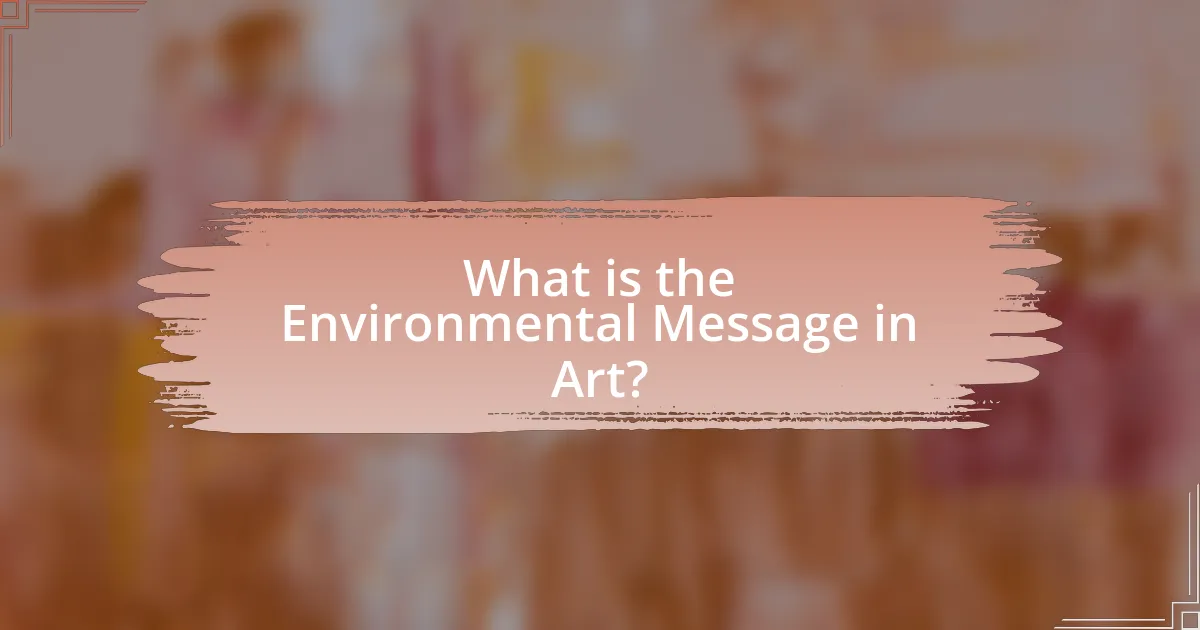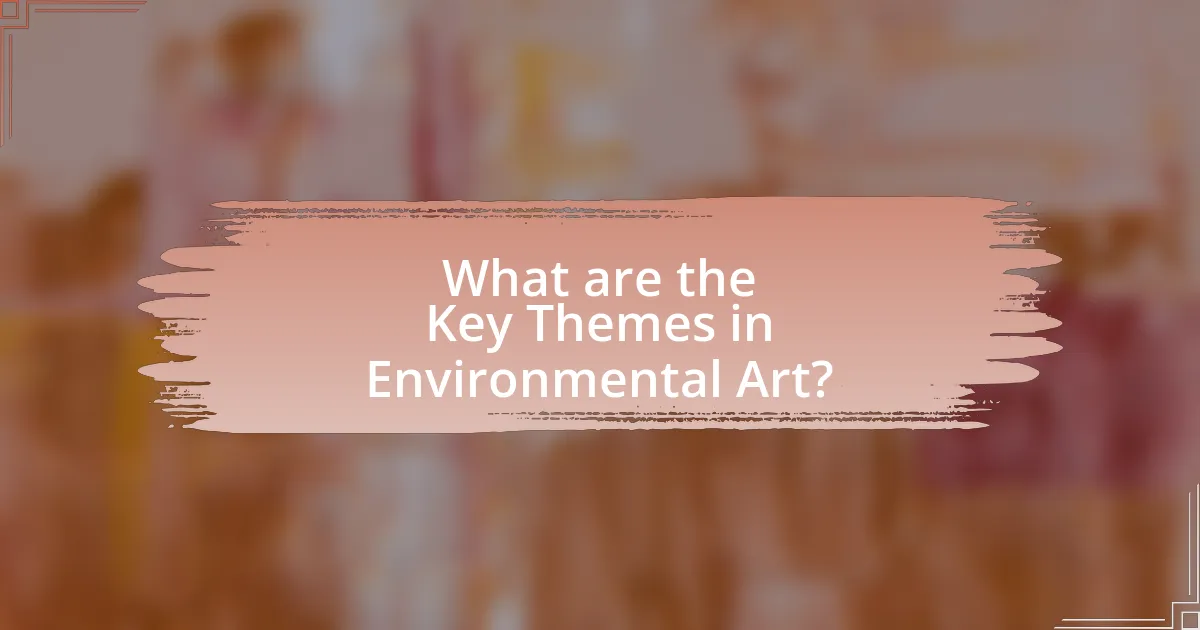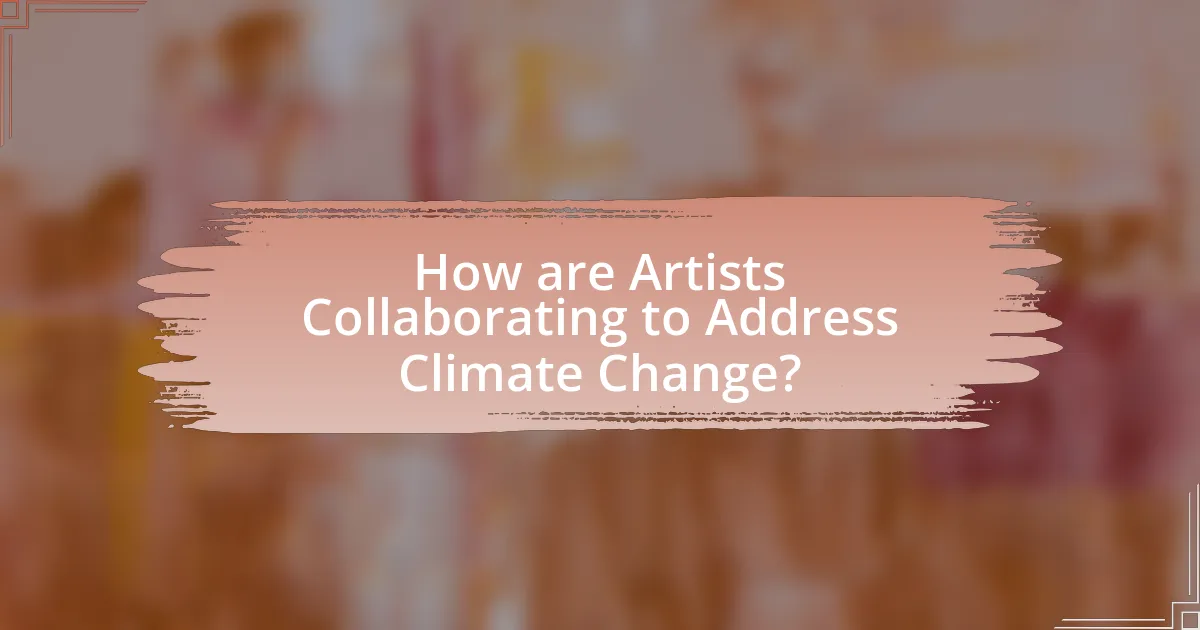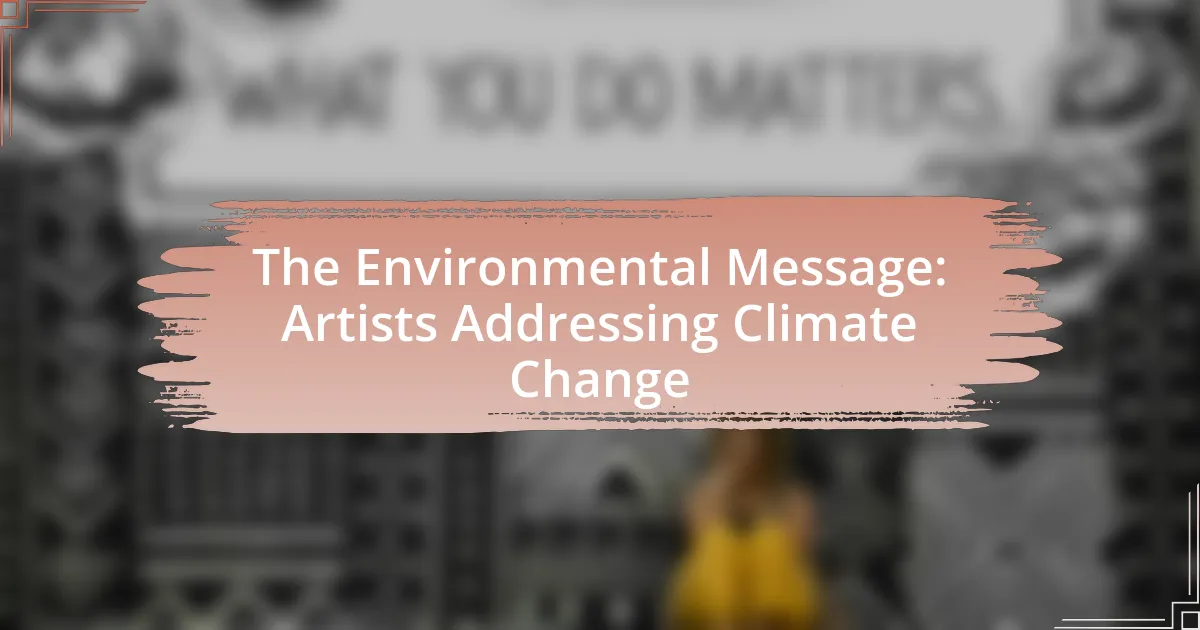The article focuses on the environmental message conveyed through art, highlighting how artists address climate change and ecological degradation. It explores various mediums used by artists, such as visual art, music, and performance, to raise awareness and inspire action regarding environmental issues. Key themes include the relationship between humans and nature, sustainability, and activism, with examples of significant art movements and contemporary projects that engage communities in climate action. The article also discusses the psychological impact of art on viewers and the effectiveness of collaborative efforts between artists, scientists, and activists in promoting environmental awareness.

What is the Environmental Message in Art?
The environmental message in art conveys the urgency of addressing climate change and environmental degradation. Artists utilize their work to raise awareness, provoke thought, and inspire action regarding ecological issues. For instance, the “Earthworks” movement, initiated in the late 1960s, emphasized the relationship between art and nature, showcasing how human activity impacts the environment. Additionally, contemporary artists like Olafur Eliasson create installations that highlight climate change’s effects, such as melting glaciers, thereby making the abstract concept of climate change more tangible and relatable. This artistic approach not only communicates the severity of environmental crises but also encourages viewers to engage with and reflect on their role in the ecosystem.
How do artists convey messages about climate change?
Artists convey messages about climate change through various mediums such as visual art, music, literature, and performance. They utilize symbolism, imagery, and narrative techniques to evoke emotional responses and raise awareness about environmental issues. For instance, the artwork “The Iceberg” by artist Olafur Eliasson visually represents the melting ice caps, highlighting the urgency of climate change. Additionally, musicians like Billie Eilish address climate themes in their lyrics, prompting listeners to reflect on their environmental impact. These artistic expressions serve to engage audiences, provoke thought, and inspire action regarding climate change.
What mediums do artists use to express environmental concerns?
Artists use various mediums to express environmental concerns, including painting, sculpture, photography, installation art, and digital media. For instance, painting allows artists to depict landscapes affected by climate change, while sculpture can utilize recycled materials to highlight waste issues. Photography captures the stark realities of environmental degradation, and installation art often creates immersive experiences that provoke thought about ecological issues. Digital media, including video and social media campaigns, enables artists to reach broader audiences and engage them in discussions about sustainability. These mediums effectively communicate the urgency of environmental issues and inspire action.
How do visual elements enhance the environmental message?
Visual elements enhance the environmental message by creating immediate emotional connections and conveying complex ideas succinctly. For instance, striking imagery of natural landscapes can evoke feelings of beauty and urgency regarding climate preservation, while infographics can simplify data on environmental issues, making them more accessible. Research indicates that visuals can increase information retention by up to 65%, demonstrating their effectiveness in communicating critical environmental messages.
Why is art an effective tool for raising awareness about climate change?
Art is an effective tool for raising awareness about climate change because it engages emotions and fosters a deeper connection to the issue. Visual and performing arts can convey complex environmental messages in a relatable manner, making abstract concepts more tangible. For instance, installations like Olafur Eliasson’s “Ice Watch,” which features large blocks of ice melting in public spaces, provide a visceral experience that highlights the urgency of climate change. Research indicates that emotional engagement through art can lead to increased public concern and motivation to act, as demonstrated in studies published by the American Psychological Association, which show that emotional responses can significantly influence attitudes and behaviors regarding environmental issues.
What psychological impacts does art have on viewers regarding environmental issues?
Art significantly influences viewers’ psychological responses to environmental issues by evoking emotional engagement and fostering awareness. This emotional engagement can lead to increased empathy towards nature and a heightened sense of urgency regarding climate change. Research indicates that art can effectively communicate complex environmental messages, making them more relatable and impactful. For instance, a study published in the journal “Environmental Communication” by authors such as M. A. K. H. van der Linden highlights that visual art can enhance public understanding of climate change by transforming abstract data into tangible experiences. This transformation often results in a shift in attitudes and behaviors, encouraging viewers to take action in support of environmental sustainability.
How does art foster community engagement in climate action?
Art fosters community engagement in climate action by creating emotional connections and raising awareness about environmental issues. Through visual art, performances, and installations, artists can convey complex climate narratives in accessible ways, prompting discussions and inspiring collective action. For instance, public art projects like “The Ocean Cleanup” not only highlight ocean pollution but also mobilize local communities to participate in cleanup efforts. Studies show that communities involved in artistic climate initiatives report increased awareness and motivation to engage in sustainable practices, demonstrating art’s effectiveness in galvanizing public interest and action towards climate change.
What historical context influences the environmental message in art?
The historical context influencing the environmental message in art includes the rise of environmental movements, particularly since the 1960s, which coincided with increased awareness of ecological issues. The publication of Rachel Carson’s “Silent Spring” in 1962 marked a pivotal moment, highlighting the dangers of pesticides and sparking public concern about environmental degradation. Additionally, the establishment of Earth Day in 1970 galvanized artists to engage with ecological themes, reflecting societal shifts towards sustainability and conservation. The 1980s and 1990s saw the emergence of eco-art, where artists began to directly address climate change and environmental justice, using their work to advocate for ecological awareness and action. This historical backdrop underscores how art has evolved as a response to environmental crises, shaping its messages and themes.
How have past art movements addressed environmental themes?
Past art movements have addressed environmental themes by reflecting societal concerns about nature and ecological issues through various artistic expressions. For instance, the Romantic movement emphasized the beauty of nature and the sublime, often portraying landscapes that highlighted humanity’s connection to the natural world. The Hudson River School, a group of American landscape painters in the 19th century, depicted the American wilderness, fostering an appreciation for nature and raising awareness about its preservation. Additionally, the Dada and Surrealist movements critiqued industrialization and its impact on the environment, using absurdity and dream-like imagery to challenge conventional perceptions of nature. In the 1960s and 1970s, the Land Art movement directly engaged with the environment by creating large-scale works in natural settings, prompting discussions about land use and ecological sustainability. These movements collectively illustrate how art has historically served as a medium for environmental advocacy and awareness.
What role did significant environmental events play in shaping artistic responses?
Significant environmental events have profoundly influenced artistic responses by serving as catalysts for creativity and social commentary. For instance, the 1986 Chernobyl disaster inspired numerous artists to explore themes of nuclear fallout and environmental degradation, leading to works that reflect societal fears and the consequences of human actions on nature. Similarly, the increasing frequency of natural disasters due to climate change, such as Hurricane Katrina in 2005, prompted artists to address issues of vulnerability, resilience, and the urgent need for environmental awareness in their creations. These events not only provide subject matter but also evoke emotional responses that drive artists to engage with pressing ecological issues, thereby shaping a collective artistic narrative focused on climate change and environmental justice.

What are the Key Themes in Environmental Art?
Key themes in environmental art include the exploration of nature, the impact of climate change, and the relationship between humans and the environment. Artists often use their work to raise awareness about ecological issues, such as deforestation, pollution, and biodiversity loss. For instance, the work of artists like Olafur Eliasson emphasizes the urgency of climate action through immersive installations that engage viewers with natural phenomena. Additionally, environmental art frequently incorporates sustainable practices and materials, reflecting a commitment to ecological responsibility. This thematic focus not only highlights environmental degradation but also inspires dialogue and action towards sustainability.
How do different themes reflect various aspects of climate change?
Different themes in art reflect various aspects of climate change by illustrating its multifaceted impacts, such as environmental degradation, social justice, and human resilience. For instance, themes of nature often depict the stark realities of habitat loss and biodiversity decline, as seen in works that showcase deforestation or melting glaciers. Additionally, social justice themes highlight the disproportionate effects of climate change on marginalized communities, emphasizing the need for equitable solutions. Furthermore, themes of hope and resilience portray human adaptability and innovation in the face of climate challenges, encouraging proactive engagement. These artistic representations serve as powerful tools for raising awareness and prompting action, as evidenced by exhibitions like “The Climate Crisis: Art and Action,” which directly address these critical issues through visual storytelling.
What themes are commonly explored in environmental art?
Common themes explored in environmental art include climate change, sustainability, biodiversity, and the relationship between humans and nature. Artists often address climate change by highlighting its impacts through visual representations, such as melting glaciers or deforestation, to evoke emotional responses and raise awareness. Sustainability is frequently depicted through the use of recycled materials or eco-friendly practices, emphasizing the importance of conserving resources. Biodiversity is showcased by illustrating endangered species and fragile ecosystems, aiming to foster a sense of urgency for their protection. The relationship between humans and nature is explored through works that critique industrialization and promote a harmonious coexistence with the environment. These themes collectively serve to engage audiences in critical conversations about ecological issues and inspire action.
How do artists interpret the theme of sustainability in their work?
Artists interpret the theme of sustainability in their work by incorporating eco-friendly materials, addressing environmental issues, and promoting awareness of climate change. For instance, many contemporary artists use recycled materials to create their pieces, emphasizing the importance of reducing waste. Additionally, artists like Olafur Eliasson create installations that engage viewers with natural phenomena, prompting reflection on humanity’s relationship with nature. Research shows that art can influence public perception and inspire action regarding sustainability, as evidenced by initiatives like the “Art for the Earth” project, which aims to raise awareness about environmental challenges through artistic expression.
Why is the theme of activism prevalent in environmental art?
The theme of activism is prevalent in environmental art because artists use their work to raise awareness about climate change and environmental issues. This artistic approach serves as a powerful tool for social change, engaging audiences emotionally and intellectually. For instance, works like Olafur Eliasson’s “Ice Watch,” which features large blocks of ice placed in public spaces, directly confront viewers with the tangible effects of global warming, prompting reflection and action. Additionally, the urgency of the climate crisis has led to a surge in art that not only critiques environmental degradation but also advocates for sustainable practices, as seen in the initiatives of organizations like the Center for Art and Environment. This intersection of art and activism effectively mobilizes communities and influences public discourse on environmental policies.
How do artists use their work to advocate for policy changes?
Artists use their work to advocate for policy changes by creating impactful visual and performance art that highlights environmental issues and mobilizes public opinion. For instance, artists like Olafur Eliasson use installations to raise awareness about climate change, directly influencing policy discussions by engaging audiences emotionally and intellectually. Additionally, campaigns such as “Art for the Earth” leverage art to communicate urgent environmental messages, prompting viewers to advocate for legislative action. Research indicates that art can effectively shift public perception and inspire collective action, as seen in the success of the “Fridays for Future” movement, which was significantly supported by artistic expressions that resonated with youth and policymakers alike.
What examples illustrate the impact of activist art on public perception?
Activist art significantly influences public perception regarding climate change through various impactful examples. One notable instance is the “Ice Watch” project by Olafur Eliasson and geologist Minik Rosing, where large blocks of ice from Greenland were displayed in urban settings to visually represent the effects of climate change. This installation raised awareness about melting ice caps and prompted discussions on global warming, effectively altering public attitudes towards environmental issues. Another example is the “The Ocean Cleanup” initiative, which combines art and technology to address ocean plastic pollution. By visually showcasing the scale of the problem through art installations, it has garnered media attention and public support, leading to increased advocacy for cleaner oceans. These examples demonstrate how activist art can engage audiences emotionally and intellectually, fostering a greater understanding of environmental challenges.
What role does nature play in environmental art themes?
Nature serves as the primary subject and inspiration in environmental art themes, highlighting the relationship between humanity and the natural world. Artists utilize natural elements to convey messages about ecological issues, often aiming to raise awareness about climate change and environmental degradation. For instance, works like Andy Goldsworthy’s site-specific installations emphasize the beauty and fragility of nature, prompting viewers to reflect on their impact on the environment. This artistic approach not only showcases the aesthetic value of nature but also serves as a call to action, urging society to engage in conservation efforts and rethink their relationship with the planet.
How do artists depict the beauty and fragility of nature?
Artists depict the beauty and fragility of nature through various mediums, emphasizing delicate ecosystems and the impact of human activity. They often use vibrant colors and intricate details to showcase natural landscapes, flora, and fauna, highlighting their aesthetic appeal. For instance, the works of artists like Claude Monet capture the ephemeral qualities of light and water, illustrating nature’s transient beauty. Additionally, contemporary artists such as Olafur Eliasson create installations that reflect environmental issues, drawing attention to the vulnerability of ecosystems. This approach not only celebrates nature’s splendor but also serves as a poignant reminder of its fragility in the face of climate change, effectively merging artistic expression with environmental advocacy.
What messages about biodiversity are conveyed through environmental art?
Environmental art conveys messages about biodiversity by highlighting the interconnectedness of ecosystems and the urgent need for conservation. Artists use visual representations to illustrate the beauty and complexity of natural habitats, often emphasizing the impact of human activity on these systems. For instance, works that depict endangered species or habitat destruction serve to raise awareness about the loss of biodiversity and its consequences for ecological balance. Research shows that engaging with environmental art can foster a deeper emotional connection to nature, prompting individuals to take action in support of biodiversity conservation.

How are Artists Collaborating to Address Climate Change?
Artists are collaborating to address climate change through interdisciplinary projects that combine visual art, performance, and activism. These collaborations often involve partnerships with scientists, environmental organizations, and communities to raise awareness and inspire action. For instance, initiatives like “The Ocean Cleanup” engage artists to create impactful installations that highlight ocean pollution, while projects such as “Artivism” merge art with advocacy to mobilize public support for climate policies. Evidence of this collaboration can be seen in events like the “COP26” climate conference, where artists showcased works that visually represented climate data, effectively communicating the urgency of the crisis to a broader audience.
What collaborative projects are currently addressing environmental issues?
Collaborative projects currently addressing environmental issues include the “Art for the Earth” initiative, which brings together artists and environmental organizations to create awareness about climate change through art installations and exhibitions. This project has successfully engaged communities in discussions about sustainability and conservation, exemplified by the “Ocean Plastic Project,” where artists use recycled materials to highlight ocean pollution. Additionally, the “Climate Art Project” collaborates with scientists and activists to produce artworks that visualize climate data, fostering a deeper understanding of environmental challenges. These projects demonstrate the power of art in mobilizing public engagement and promoting environmental stewardship.
How do artists partner with scientists and activists?
Artists partner with scientists and activists by collaborating on projects that merge creative expression with scientific research and social advocacy. This partnership often involves artists using their work to visualize complex scientific data, making it more accessible and engaging to the public. For instance, initiatives like the “Art and Climate Change” project have successfully brought together artists and climate scientists to create installations that highlight the impacts of climate change, thereby raising awareness and prompting action. Such collaborations leverage the unique strengths of each discipline, with artists enhancing communication and emotional resonance while scientists provide factual grounding and context.
What are the outcomes of these collaborations for climate awareness?
Collaborations among artists addressing climate change significantly enhance climate awareness by creating impactful visual narratives that resonate with diverse audiences. These partnerships often result in large-scale art installations, public performances, and multimedia projects that effectively communicate the urgency of climate issues. For instance, the “Artivism” movement has seen artists like Olafur Eliasson and Ai Weiwei engage in projects that draw attention to environmental degradation, leading to increased public discourse and engagement on climate action. Research indicates that such artistic expressions can evoke emotional responses, prompting individuals to reconsider their relationship with the environment and inspiring collective action towards sustainability.
How can community involvement enhance artistic efforts in climate action?
Community involvement can enhance artistic efforts in climate action by fostering collaboration and amplifying diverse voices. When local communities engage in artistic projects, they contribute unique perspectives and experiences that reflect their specific environmental challenges and cultural contexts. This collaboration can lead to more impactful and relatable art that resonates with a broader audience. For instance, community-driven art initiatives, such as murals or performances, can raise awareness about local climate issues, mobilize public support, and inspire collective action. Research shows that participatory art projects can increase community cohesion and empower individuals to advocate for environmental change, as evidenced by the success of initiatives like the “Climate Change Theatre Action,” which involves communities worldwide in performances addressing climate issues.
What initiatives encourage public participation in environmental art projects?
Initiatives that encourage public participation in environmental art projects include community workshops, collaborative installations, and public art festivals. Community workshops allow local residents to engage directly with artists, fostering a sense of ownership and connection to the artwork. Collaborative installations often involve participants in the creation process, which can enhance awareness of environmental issues. Public art festivals, such as the “Art in the Park” events, provide platforms for artists and the community to interact, share ideas, and promote environmental messages through art. These initiatives have been shown to increase public engagement and awareness of climate change and sustainability issues.
How do community-based art projects impact local environmental issues?
Community-based art projects significantly impact local environmental issues by raising awareness and fostering community engagement. These projects often utilize public spaces to visually communicate environmental challenges, such as pollution or climate change, thereby educating the public and inspiring action. For instance, a study by the University of California, Berkeley, found that community art initiatives led to a 30% increase in local participation in environmental clean-up efforts. By creating a shared sense of ownership and responsibility, these art projects not only highlight environmental concerns but also mobilize community members to advocate for sustainable practices and policies.
What are some successful examples of environmental art initiatives?
Successful examples of environmental art initiatives include the “Ice Watch” project and Christo and Jeanne-Claude’s “The Gates.” The “Ice Watch” project involved the installation of large blocks of ice in public spaces to raise awareness about climate change, specifically highlighting the melting of Greenland’s ice sheets. This initiative was executed in cities like Copenhagen and Paris, where the ice blocks melted over time, visually demonstrating the urgency of climate action. Christo and Jeanne-Claude’s “The Gates,” installed in Central Park, consisted of 7,503 gates with flowing fabric, which drew attention to the natural landscape and encouraged public engagement with environmental issues. Both initiatives effectively combined art with activism, fostering dialogue about climate change and inspiring community involvement.
How have specific art installations influenced public discourse on climate change?
Specific art installations have significantly influenced public discourse on climate change by engaging audiences emotionally and intellectually, prompting discussions about environmental issues. For instance, Olafur Eliasson’s “Ice Watch,” which involved placing large blocks of ice in public spaces, visually represented the melting glaciers and raised awareness about global warming. This installation not only attracted media attention but also encouraged viewers to reflect on their personal impact on the environment. Similarly, the “The Ocean Cleanup” project, which combines art and technology, has sparked conversations about plastic pollution in oceans, emphasizing the urgency of addressing climate change. These installations serve as powerful tools for advocacy, transforming abstract climate data into tangible experiences that resonate with the public, thereby fostering a more informed and engaged discourse on climate action.
What lessons can be learned from successful environmental art campaigns?
Successful environmental art campaigns demonstrate the importance of engaging storytelling to convey complex climate issues effectively. These campaigns often utilize visual art to evoke emotional responses, making abstract concepts more relatable and urgent. For instance, the “Ice Watch” project, where large blocks of ice were placed in urban settings, visually represented the impact of climate change, prompting public dialogue and awareness. Additionally, collaboration between artists, scientists, and communities enhances the credibility and reach of the message, as seen in the “Ocean Plastic” art installations that highlight marine pollution. These examples illustrate that successful campaigns leverage emotional engagement, collaboration, and clear messaging to inspire action and awareness regarding environmental issues.
What practical steps can artists take to effectively address climate change through their work?
Artists can effectively address climate change through their work by incorporating sustainable practices, raising awareness, and engaging in community initiatives. By using eco-friendly materials and methods, such as recycled or biodegradable supplies, artists can minimize their environmental impact. Additionally, creating art that highlights climate issues can educate the public and provoke discussions, as seen in projects like Olafur Eliasson’s “Ice Watch,” which visually represents the melting glaciers. Furthermore, collaborating with environmental organizations allows artists to amplify their message and participate in local conservation efforts, demonstrating a commitment to climate action.


